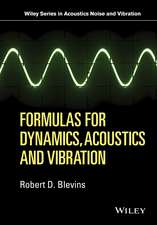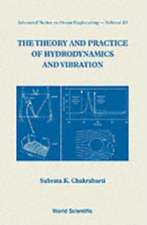Control of Noise and Structural Vibration: A MATLAB®-Based Approach
Autor Qibo Mao, Stanislaw Pietrzkoen Limba Engleză Hardback – 14 iun 2013
| Toate formatele și edițiile | Preț | Express |
|---|---|---|
| Paperback (1) | 1042.74 lei 38-44 zile | |
| SPRINGER LONDON – 16 iul 2015 | 1042.74 lei 38-44 zile | |
| Hardback (1) | 1232.89 lei 6-8 săpt. | |
| SPRINGER LONDON – 14 iun 2013 | 1232.89 lei 6-8 săpt. |
Preț: 1232.89 lei
Preț vechi: 1503.53 lei
-18% Nou
Puncte Express: 1849
Preț estimativ în valută:
235.95€ • 245.42$ • 194.78£
235.95€ • 245.42$ • 194.78£
Carte tipărită la comandă
Livrare economică 12-26 aprilie
Preluare comenzi: 021 569.72.76
Specificații
ISBN-13: 9781447150909
ISBN-10: 1447150902
Pagini: 446
Ilustrații: XII, 369 p. 332 illus., 107 illus. in color.
Dimensiuni: 155 x 235 x 22 mm
Greutate: 0.88 kg
Ediția:2013
Editura: SPRINGER LONDON
Colecția Springer
Locul publicării:London, United Kingdom
ISBN-10: 1447150902
Pagini: 446
Ilustrații: XII, 369 p. 332 illus., 107 illus. in color.
Dimensiuni: 155 x 235 x 22 mm
Greutate: 0.88 kg
Ediția:2013
Editura: SPRINGER LONDON
Colecția Springer
Locul publicării:London, United Kingdom
Public țintă
ResearchCuprins
Introduction.- Vibration and Sound Radiation.- Introduction Examples on Control of Sound and Vibration.- Distributed Transducers by Using Smart Materials.- Feedback Control.- Positive Position Feedback Control.- Semi-active Control Using Helmholtz Resonators.- Shunt Piezoelectric Circuits.
Textul de pe ultima copertă
Control of Noise and Structural Vibration presents a MATLAB®-based approach to solving the problems of undesirable noise generation and transmission by structures and of undesirable vibration within structures in response to environmental or operational forces.
The fundamentals of acoustics, vibration and coupling between vibrating structures and the sound fields they generate are introduced including a discussion of the finite element method for vibration analysis. Following this, the treatment of sound and vibration control begins, illustrated by example systems such as beams, plates and double plate structures. Sensor and actuator placement is explained as is the idea of modal sensor–actuators. The design of appropriate feedback systems includes consideration of basic stability criteria and robust active structural acoustic control. Single and multi-mode positive position feedback (PPF) control systems are also described in the context of loudspeaker–duct model with non-collocated loudspeaker–microphones. The design of various components is detailed including the analogue circuit for PPF, adaptive (semi-active) Helmholtz resonators and shunt piezoelectric circuits for noise and vibration suppression.
The text makes extensive use of MATLAB® examples and these can be simulated using files available for download from the book’s webpage at springer.com. End-of-chapter exercises will help readers to assimilate the material as they progress through the book.
Control of Noise and Structural Vibration will be of considerable interest to the studentof vibration and noise control and also to academic researchers working in the field. Its tutorial features will help practitioners who wish to update their knowledge with self-study.
The fundamentals of acoustics, vibration and coupling between vibrating structures and the sound fields they generate are introduced including a discussion of the finite element method for vibration analysis. Following this, the treatment of sound and vibration control begins, illustrated by example systems such as beams, plates and double plate structures. Sensor and actuator placement is explained as is the idea of modal sensor–actuators. The design of appropriate feedback systems includes consideration of basic stability criteria and robust active structural acoustic control. Single and multi-mode positive position feedback (PPF) control systems are also described in the context of loudspeaker–duct model with non-collocated loudspeaker–microphones. The design of various components is detailed including the analogue circuit for PPF, adaptive (semi-active) Helmholtz resonators and shunt piezoelectric circuits for noise and vibration suppression.
The text makes extensive use of MATLAB® examples and these can be simulated using files available for download from the book’s webpage at springer.com. End-of-chapter exercises will help readers to assimilate the material as they progress through the book.
Control of Noise and Structural Vibration will be of considerable interest to the studentof vibration and noise control and also to academic researchers working in the field. Its tutorial features will help practitioners who wish to update their knowledge with self-study.
Caracteristici
Shows the reader how to exploit smart materials for the measurement and control of sound radiation from vibrating structures Demonstrates active and passive control of sound transmission through double-wall structures like double-glazed windows Extensive use of MATLAB® makes the examples described in the text easily reproduced and modified by the reader














